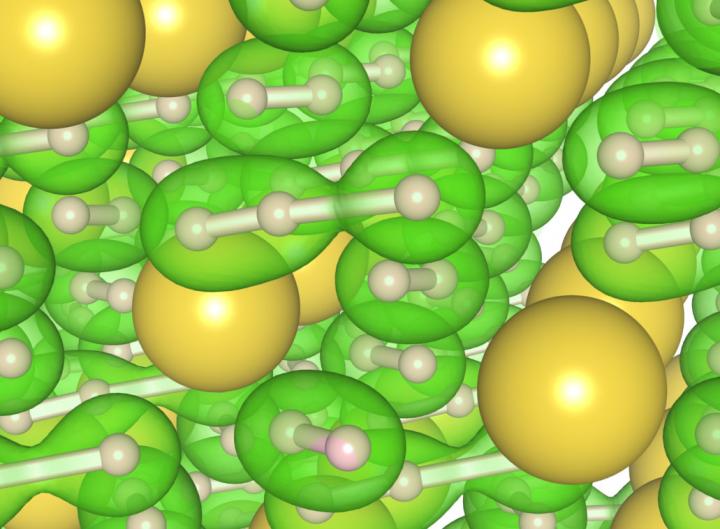New material could advance superconductivity

At center, in green, is the new three-atom hydrogen 'chain.' It is surrounded by several 'normal' two-atom molecules of hydrogen, also in green. The new chain configuration appears in the new material NaH7, which was produced under high pressure and high temperature conditions. The new material could change the superconductivity landscape and be useful for hydrogen storage in hydrogen fuel cells. Image courtesy Duck Young Kim
It had been predicted that certain hydrogen-rich compounds consisting of multiple atoms of hydrogen with so-called alkali metals like lithium, potassium or sodium, could provide a new chemical means to alter the compound's electronic structure. This, in turn, may lead the way to metallic high-temperature superconductors.
“The challenge is temperature,” explained Struzhkin. “The only superconductors that have been produced can only exist at impractically cold temperatures. In recent years, there have been predictions of compounds with several atoms of hydrogen coupled with alkali metals that could exist at more practical temperatures. They are theorized to have unique properties useful to superconductivity.”
Now, the predictions have been confirmed. The Struzhkin team included Carnegie researchers Duck Young Kim, Elissaios Stavrou, Takaki Muramatsu, Ho-Kwang Mao, and Alexander Goncharov, with researchers from other institutions.*
The team used theory to guide their experiments and measured the samples using both a method that reveals the atomic structure (X-ray diffraction) and a method that identifies molecules by characteristics such as their minute vibrations and rotations (Raman spectroscopy). Theoretically, the sodium/hydrogen material would be stable under pressure, have metallic characteristics and unique structures, and show superconducting properties.
The team conducted high-pressure/high-temperature experiments. Matter under these extreme conditions can morph into new structures with new properties. They squeezed lithium and sodium samples in a diamond anvil cell to enormous pressures while heating the samples using a laser. At pressures between 300,000 and 400,000 atmospheres (30-40 gigapascals, or GPa) and temperatures of about 3100°F (2000 kelvin), they observed, for the first time, structures of “polyhydrides,” sodium with 3 hydrogen atoms (NaH3) and NaH7–sodium with seven atoms of hydrogen–in very unusual configurations. Three negative charged hydrogen atoms in the NaH7 material lined up and looked like one-dimensional hydrogen chains, which is a new phase that is very different from pure hydrogen.
“This configuration was originally predicted to exist in 1972, more than 40 years ago,” remarked Duck Young Kim. “It turns out that our experiments are in complete agreement with the theory, which predicted the existence of NaH3. The bonus is that we also observed the compound with seven hydrogen atoms.”
Struzhkin reflected, “Further work needs to be done to see if materials in this class can be produced at lower temperatures and pressures. But this new class of matter opens up a whole new world of possibilities.”
###
Caption: At center, in green, is the new three-atom hydrogen “chain.” It is surrounded by several “normal” two-atom molecules of hydrogen, also in green. The new chain configuration appears in the new material NaH7, which was produced under high pressure and high temperature conditions. The new material could change the superconductivity landscape and be useful for hydrogen storage in hydrogen fuel cells. Image courtesy Duck Young Kim
*Other researcher include Chris Pickard with the University College, London; Richard Needs of the Cavendish Laboratory in the UK; and Vitali Prakapenda of the University of Chicago. This work was supported by the DOE/BES; the Energy Frontier Research in Extreme Environments Center (EFree); the Engineering and Physical Sciences Research Council (EPSRC) of the UK; DARPA; and NSFC.
The Carnegie Institution for Science is a private, nonprofit organization headquartered in Washington, D.C., with six research departments throughout the U.S. Since its founding in 1902, the Carnegie Institution has been a pioneering force in basic scientific research. Carnegie scientists are leaders in plant biology, developmental biology, astronomy, materials science, global ecology, and Earth and planetary science.
Media Contact
All latest news from the category: Materials Sciences
Materials management deals with the research, development, manufacturing and processing of raw and industrial materials. Key aspects here are biological and medical issues, which play an increasingly important role in this field.
innovations-report offers in-depth articles related to the development and application of materials and the structure and properties of new materials.
Newest articles

Properties of new materials for microchips
… can now be measured well. Reseachers of Delft University of Technology demonstrated measuring performance properties of ultrathin silicon membranes. Making ever smaller and more powerful chips requires new ultrathin…

Floating solar’s potential
… to support sustainable development by addressing climate, water, and energy goals holistically. A new study published this week in Nature Energy raises the potential for floating solar photovoltaics (FPV)…

Skyrmions move at record speeds
… a step towards the computing of the future. An international research team led by scientists from the CNRS1 has discovered that the magnetic nanobubbles2 known as skyrmions can be…





















